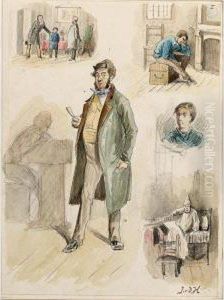Johan Jacob Van Der Heyden Paintings
Johannes van der Heyden was a Dutch Baroque-era painter, draughtsman, printmaker, and inventor who was born on March 5, 1637, in Gorinchem, Netherlands. He is best known for his detailed paintings of cityscapes and architecture, bringing a level of precision and realism to his work that was quite innovative for his time. Van der Heyden's paintings often feature the streets and buildings of Dutch cities such as Amsterdam, as well as other European locations.
Van der Heyden's family moved to Amsterdam in his youth, and he was likely educated there. Although it is believed that he may have been apprenticed under a painter, his early training is largely unknown. Unlike many of his contemporaries, van der Heyden did not solely devote himself to painting; he also had a keen interest in various technical subjects and inventions, particularly in the area of street lighting. His improvements to the design and functionality of street lamps significantly impacted the public infrastructure of Amsterdam and other cities.
In 1661, he married Sara ter Hiel of Utrecht, with whom he had several children. Van der Heyden's works were collected by influential patrons, which provided him with financial security. He was also an active member of the artist's guild in Amsterdam.
Despite his success as an artist, van der Heyden's technical interests remained a significant part of his life. He worked as an engineer and even published a book on firefighting, including designs for fire hoses and pumps, which were another of his contributions to public safety.
Johannes van der Heyden's artistry was characterized by his meticulous attention to detail, which can be seen in the way he rendered brickwork, reflections in windows, and the play of light and shadow. His paintings also exhibit a masterful use of perspective, which helped to create a sense of depth and realism in his urban landscapes.
Van der Heyden died on September 28, 1712, in Amsterdam. His legacy as both an artist and an inventor has cemented his place in Dutch Golden Age history. While he may not be as widely recognized as some of his contemporaries, van der Heyden's contributions to the arts and to the development of urban infrastructure were significant and continue to be appreciated by art historians and city planners alike.

